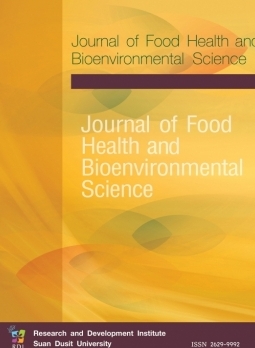Effect of Horse Mango (Mangifera foetida) Pulp on Quality and Consumer Acceptance of Sherbet Ice Cream
Keywords:
Sherbet, Mangifera foetida, Ice cream, Consumer acceptanceAbstract
This objective of this research was to develop the local fruit of Thailand, horse mango (Mangifera foetida) into sherbet ice cream. Horse mango sherbet ice cream with 3 difference level of horse mango pulp (20, 40 and 60%) were study with physical quality, chemical quality microbiological quality and consumer acceptance. The results showed, yellowness color increasing related to quantity of horse mango pulp; so the 60% horse mango pulp content sherbet ice cream is the brightest yellow. Overrun value of 20, 40 and 60% horse mango pulp sherbet ice cream were 20.19 ± 0.91, 20.18 ± 0.32, 19.91 ± 0.37 respectively, it’s statistically not significant (p> 0.05). The texture in each of the 3 levels of pulp was different, and increasing the horse mango pulp meant the firmness decreased. The melting rate was increased when increasing horse mango pulp. Energy, carbohydrate, protein, ash and retinol variation all increased when the level of of horse mango pulp increased. Microbiological quality followed Ministry of Public Health standards. Additionally, a higher concentration of fruit pulp increased the value of panelist’s sensory score for color, odor, texture and overall acceptance.
References
AOAC. (2005). Official Method of Analysis (18th ed.). Washington D.C.: Association of Official Chemists. Rockville, Maryland.
Badem, A., & Alpkent, Z. (2018). Production of ice cream with carob bean pekmez (molasses). International Journal of Environment, Agriculture and Biotechnology, 3, 28-32. Food Intelligent Center, Thailand. (2017). Ice cream market in Thailand. Retrieved December 5, 2020, from http://fic.nfi.or.th/MarketOverviewDomesticDetail.php?id=160
Garcia R.S., Marshall R.T., & Heymann H. (1995). Low fat ice creams from freeze-concentrated versus heatconcentrated nonfat milk solids. J. Dairy Sci., 78, 2345-2351.
Hyoung S., & Gary A. (2003). Effect of thermal pasteurization on Valencia orange juice color and pigments. LWTFood Science and Technology, 36(1), 153-156.
Januario J.G.B., Oliveira, A.S., Dias, S.S., Klososki, S.J., & Pimentel, T.C. (2018). Kefir ice cream flavored with fruits and sweetened with honey:Physical and chemical characteristics and acceptance. International Food Research Journal, 25,179-187.
Manfah, M., & Nivet, P. (2015). Product development of Mangifera indica L.Var. to sherbet (Independent study). Trang: Suan Dusit University.
Maturin, L.J., & Peeler, J.T. (2001).Chapter 3, aeribic plate count. Retrieved October 19, 2020, from https://www.fda.gov/food/laboratory-methods-food/bam-chapter-3-aerobic-plate-count.
Muse, M.R., & Hatel, R.W. (2004). Ice cream structural elements that effect melting rate and hardness. Journal of Dairy Science, 87, 1-10.
Petruzzi, L., Campaniello, D., Speranza, B., Corbo, M.R., Sinigaglia, M., & Bevilacqua, A. (2017). Thermal treatments for fruit and vegetable juices and beverages: A literature overview. Comprehensive Reviews in Food Science and Food Safety, 16(4), 668-691.
Rattanathanalerk, M., Chiewchan, N., & Srichumpoung, W. (2005). Effect of thermal processing on the quality loss of pineapple juice. Journal of Food engineering, 66(2), 259-265.
Rawendra, R.D., & Dwi, G.N. (2020). Enrichment of soft ice cream with different fibrous fruit puree: Physicochemical, textural characteristics and sensory properties. In IOP Conference Series: Earth and Environmental Science (p. 012178). Solo, Indonesia: IOP Publishing.
Sofjan, R.P., & Hartel, R.W. (2004). Effects of overrun on structural and physical characteristics of ice cream. International Dairy Journal, 14(3), 255-262.
Thailand Public Health. (2013). Notification of the Ministry of Public Health No.354 B.E.2556: Ice cream, Royal Thai Government Gazette 130. special issue 87.
Tyug, T.S., Johar, M.H., & Ismail, A. (2010). Antioxidant properties of fresh, powder, and fiber products of mango (Mangifera foetida) fruit. International Journal of Food Properties, 13(4), 682-691.
Downloads
Published
How to Cite
Issue
Section
License

This work is licensed under a Creative Commons Attribution-NonCommercial-NoDerivatives 4.0 International License.








